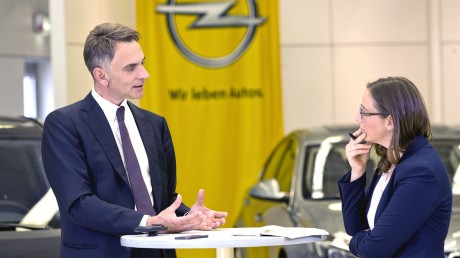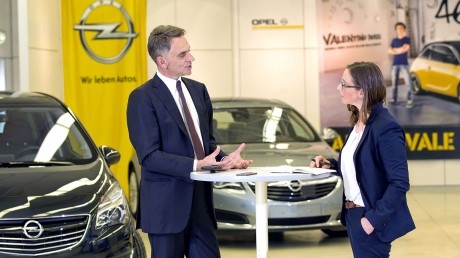- Oberster Hüter der Qualität im Unternehmen: Thomas Simon, der vor 28 seine Karriere bei Opel Wien begann.
The Meriva has managed to do something that no soccer team in the Champions League has been able to do: retain its title. For the second time in a row, the Meriva achieved the highest levels of customer satisfaction in the ‘Germany 2014’ J.D. Power VOSS (Vehicle Owner Satisfaction Study) in the compact van category. If there was a Champions League for studies, this one would be on top. Given the occasion, it’s the perfect time talk to Thomas Simon, Vice President GM Europe Quality since 1 January 2010, about defending the title, the perfect car, and the art of balance.
1. Mr. Simon, what does it mean to Opel/Vauxhall for the Meriva to retain its title in the J.D. Power VOSS report?
Simon: The Meriva achieved an approval rating of 80.4 percent, which is a fantastic result. The owners participating in the study have been driving the Meriva for two years on average, meaning they are the harshest critics. The results make one thing abundantly clear: Our focus on quality is having a direct effect on customer satisfaction, just as we planned. One of the reasons why the J.D. Power VOSS report is so important when it comes to customer satisfaction is because it covers virtually the entire range of customer experiences, from quality, attractiveness, and service right through to maintenance costs.
2. You mentioned attractiveness, service, and maintenance. These categories go beyond our understanding of quality. To what extent has the concept of quality changed?
It has changed immensely. Nowadays, quality means far more than just delivering a product that’s free of defects. It’s much more about the presence of ‘goodness.’ Every experience the customer has with the product and the brand plays a role. It goes far beyond what we call ‘hardcore quality.’ This extended concept of quality is now an integral part of our business model at GM and Opel.

In conversation: Simon Thomas with Tina Henze, Managing Editor of Opel Post.
3. If being free of defects is no longer enough, how do customers then perceive quality?
They use all of their senses. What does it look like? How do the steering wheel, driver’s seat, and gear knob feel? What does the engine sound like? What does the interior smell like? You have to be able to see and get a sense of the attention to detail and the pursuit and achievement of perfection in every nook and cranny of the car. That’s the only way to satisfy customers.
And I for one am convinced: We’ve never built cars as good as we do today. And they’ve never looked as good either. But it’s goes beyond the vehicle. Am I satisfied with the workshop? What am I reading about Opel in the papers? Every link to the brand plays a role.
4. Meriva customers are satisfied. But where does Opel/Vauxhall stand when it comes to quality as a whole?
We have gone through a re-orientation phase. It’s embodied in the DRIVE! 2022 strategy. And this applies to quality, too. Our QUALITY! 2022 initiative includes no less than ten core initiatives with the aim of achieving a top position in all vehicle segments for initial quality, durability, reliability, and customer satisfaction. We can’t afford to wait until 2022. Every new vehicle we launch is launched at the top. Competition studies show that the ADAM and Mokka models are exactly where they need to be when it comes to customer satisfaction and problems per vehicle – and that’s on top.
5. How do you know what customers want and what satisfies them?
We place customer satisfaction at the very beginning of the development process. Before any financial approvals are obtained, we determine how we want to perform. There are exactly 38 customer satisfaction attributes, including all-round view, performance, CO² emissions, attractiveness, interior design, and exterior design. We can measure each one of these attributes. We not only hope to have a realistic chance on the market with a product at the development stage – we know we will. The latest products, ADAM and Mokka, give an impressive insight into our method. And this year, we’re moving forward with Vivaro, ADAM Rocks, and the new Corsa. I can promise you one thing, there are interesting times ahead.

The interview took place on the plant grounds in Rüsselsheim.
6. Is there such a thing as the perfect car?
No, there’s no such thing as the perfect car. The foundation and the physics need to be perfect. Then it’s about understanding what our customers want and expect in each individual segment and market. A customer with a family looking for a van is likely to opt for a Zafira Tourer or Meriva, and they will have a totally different set of requirements compared to someone buying an Astra OPC. Here, one customer is looking at functionality and charging capacity, while the other is focusing on performance. We use the customer satisfaction attribute to determine which aspects of each individual vehicle that we want to stand out.
It’s not possible for a car to be the best in its class in every attribute. If that were the case, no one would be able to afford it. We have to be the best in the areas that our customers focus on. That’s where we want to be as a brand, and we want to offer the best car at a reasonable price. Here’s a good example: The Auto Test editorial staff selected the Insignia Sports Tourer 2.0 CDTI as the winner when it comes to cost-performance ratio in the mid-range class.
7. What is your everyday work routine as Vice President Quality?
Most of my days are spent looking to the future. What I mean is, ten years ago, we spent half of our working hours dealing with current issues, whereas now we use more than half of our time to look ahead to our future models. This is a good thing, because anything that’s not designed appropriately at the beginning has to be corrected at the end of the process. I devote about 30 percent of my time to current product issues, and the rest goes on the usual management tasks.
8. What issues are you working on at the moment? Can you give us an example?
In Europe, the duration of ownership of vehicles, or in other words, the length of time a customer drives a vehicle, has risen significantly. As a result, when a customer decides to buy a new vehicle, it has been many years since their last vehicle purchase. They ask themselves: What was the service like the last time I visited the repair shop to change the brake pads? How much did it cost? And, most importantly: How does the car look after five or six years? Has the leather on the seats puckered? Does the paintwork look dull? We keep an eye on these things and we are working on continuously improving them.
9. Is there a cardinal error you can make in your job?
There is one thing we can never forget: We are a carmaker. Everything begins and ends with the car. We could design a car that’s not to the taste of the customer. We could develop and build it without errors. It would run like clockwork, but we wouldn’t be able to sell it. That’s not the way to do things and neither is this: making lots of mistakes when it comes to designing, developing, and manufacturing, but having a few sales fireworks, the best building, the nicest salespeople, and a fresh pot of coffee on hand at all times. The customer would not be satisfied. It’s about getting it right and finding the right balance.
Thomas Simon has been Vice President General Motors Europe Quality since 1 January 2012. Born in 1966 in Austria, Thomas Simon began his career at Opel Vienna in 1986. His career has included positions in Rüsselsheim as Chief Engineer and Director of Powertrain Production Planning across Europe and in Turin as Vice President Quality Drive System Fiat-GM Powertrain. Simon relocated to Detroit in 2007 to take up the position as Vice President Quality & Reliability Global Powertrain. He moved back to Europe in June 2010 to become Global Vehicle Line Executive at the International Technical Development Center, responsible for GM’s compact car class all over the world.
What is J.D. Power?
J.D. Power Associates is one of the most prominent market research companies in the world. Founded in 1968 and named after creator James David Power III, the company carries a great deal of weight when it comes to customer satisfaction. The annual satisfaction survey of drivers has been conducted in Germany since 2002.
How is the J.D. Power report prepared?
The 2014 J.D. Power Report used online interviews to ask 18,000 drivers about their experiences with their car. Each participant has been driving the model for about two years. The assessment only includes models for which we received at least 50 valid responses. Over 100 responses are required for the manufacturer assessment.
How to you measure satisfaction?
The questions in the 2014 J.D. Power Report are divided into four categories: quality/reliability, attractiveness, service, and maintenance costs. All of the ratings are weighted and provide an overall satisfaction value as a percentage. Attractiveness returned the highest value with 27 percent, followed by maintenance costs with 25 percent, quality/reliability with 24 percent, and service with 23 percent.

